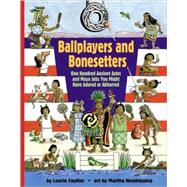
| Introduction | |
| Who Was Who in Mesoamerica | |
| Society's Pyramid | |
| Borrowers and Transformers | |
| A Very Crowded Cosmos | |
| Early Job Training | |
| City-State Jobs | |
| Surveyor | |
| Calpulli Governor | |
| Judge | |
| Tribute Collector | |
| Latrine Boatman | |
| Aqueduct Builder | |
| Pyramid-Temple Building Jobs | |
| Chief Architect | |
| Mural Painter | |
| Sculptor | |
| Quarry Worker | |
| Stonecutter | |
| Plasterer | |
| Laborer | |
| Palace Jobs | |
| Great King | |
| Juggler | |
| Poet | |
| Queen | |
| Princess | |
| Embroiderer | |
| Prince | |
| Prime Minister | |
| Ambassador | |
| Astronomer | |
| Painter-Scribe | |
| Royal Historian | |
| Servant | |
| Cook | |
| Food and Drink Jobs | |
| Hill Farmer | |
| Slave | |
| Landless Farm Laborer | |
| Chinampa Farmer | |
| Farmer's Wife | |
| Woodcutter | |
| Pulque Maker | |
| Salt Maker | |
| Everyday Crafts Jobs | |
| Blade Maker | |
| Maguey Worker | |
| Spinner | |
| Potter | |
| Adobe Brick Maker | |
| Clay Figurine Maker | |
| Rope Maker | |
| Paper Maker | |
| Metate and Mano Maker | |
| Rubber Ball Maker | |
| Mat Maker | |
| Broom Maker | |
| Canoe Builder | |
| Luxury Crafts Jobs | |
| Goldsmith | |
| Bell Maker | |
| Feather Artist's Apprentice | |
| Wood Carver | |
| Mosaic Mask Maker | |
| Shell Worker | |
| Flower Worker | |
| Trade and Market Jobs | |
| Long-Distance Merchant | |
| Porter | |
| River Boatman | |
| Chocolate Seller | |
| Sandal Seller | |
| Fruit and Vegetable Seller | |
| Dye Maker and Seller | |
| Counterfeiter | |
| Market Officer | |
| Slave Dealer | |
| Temple Jobs | |
| High Priest | |
| Sorcerer | |
| Priestess | |
| Teacher-Priest | |
| Student Priest | |
| Day-Count Reader | |
| Ceremonial Jobs | |
| Professional Ballplayer | |
| Master of Cremation Ceremony | |
| Volador | |
| Drummer | |
| Conch-Shell Player | |
| Matchmaker | |
| Dancer | |
| Deity Impersonator | |
| Military Jobs | |
| Weapons Maker | |
| Spy | |
| Eagle Elder | |
| Student Warrior | |
| Jaguar Warrior | |
| Stone Slinger | |
| Messenger | |
| Health and Beauty Jobs | |
| Herbalist | |
| Bonesetter | |
| Midwife | |
| Barber | |
| Tooth Filer | |
| Beast, Bird, and Bug Jobs | |
| Hunter | |
| Dog Breeder | |
| Tanner | |
| Bug Farmer | |
| Beekeeper | |
| Fisher | |
| Shell Diver | |
| Zookeeper | |
| Aviary Keeper | |
| After the Spanish Conquest | |
| Recommended Further Reading | |
| Acknowledgments | |
| Index | |
| Table of Contents provided by Publisher. All Rights Reserved. |
The New copy of this book will include any supplemental materials advertised. Please check the title of the book to determine if it should include any access cards, study guides, lab manuals, CDs, etc.
The Used, Rental and eBook copies of this book are not guaranteed to include any supplemental materials. Typically, only the book itself is included. This is true even if the title states it includes any access cards, study guides, lab manuals, CDs, etc.